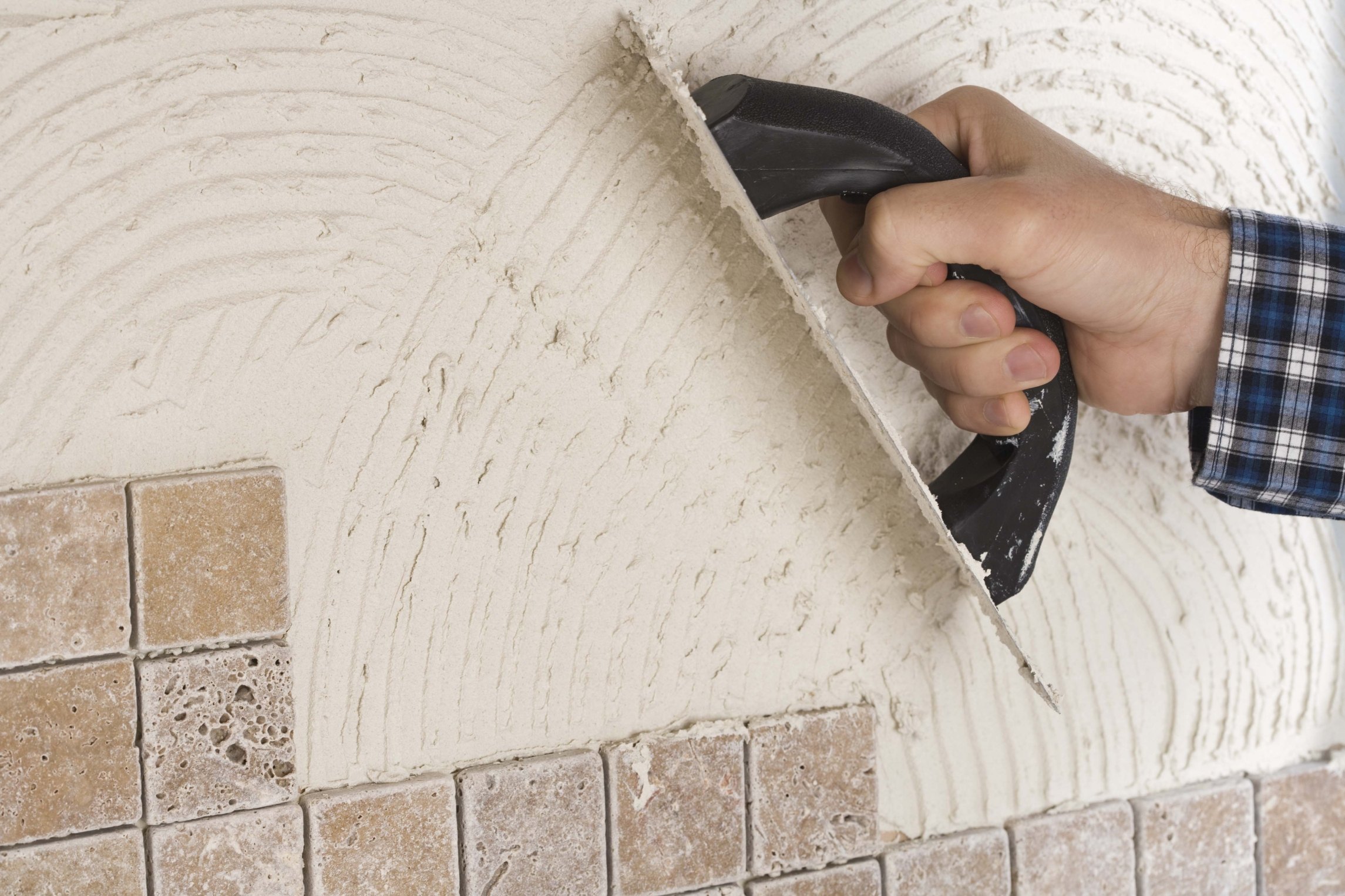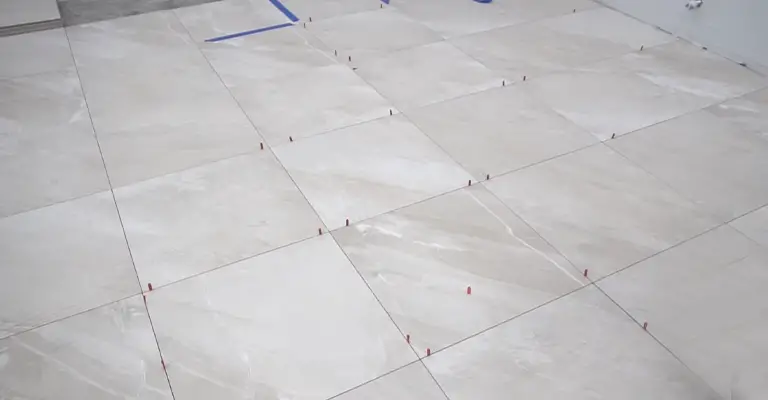Imagine your home with beautiful tiled floors, adding a touch of elegance and durability. But what if your existing concrete floor is already painted? Can you tile directly over it, or will it spell disaster for your dream renovation? The answer, as with most things in home improvement, is not always simple. It depends on the type of paint, the condition of the floor, and your desired outcome.

Image: www.ehow.com
This comprehensive guide will delve into the considerations and best practices for tiling over painted concrete floors. From understanding paint types to exploring the pros and cons of this approach, we’ll empower you with the knowledge to make an informed decision for your home.
Understanding the Challenges: Paint & Concrete
The primary concern when tiling over painted concrete is the adhesion of the tile adhesive to the paint. Some paints create a smooth, non-porous surface that resists bonding, leading to tile lifting or cracking. Additionally, painted concrete may harbor imperfections that can transfer to the tiles, affecting their appearance or even compromising their structural integrity.
Types of Paint and Their Suitability
The first step is to identify the type of paint on your concrete. Here’s a quick breakdown:
- Oil-based paint: Often used for garage floors, oil-based paint forms a hard, durable surface that is notoriously difficult to tile over. The lack of porosity makes it challenging for adhesive to bond effectively.
- Latex paint: A more common choice for interior concrete floors, latex paint is generally considered easier to tile over. However, its adhesion can still be a concern, depending on the paint’s quality and age.
- Epoxy paint: This type of paint is known for its exceptional durability and resistance, often used in garages or workshops. While it creates a very smooth surface, some epoxy paints are specifically designed to be compatible with tile adhesive, making them a good option for tiling.
When Tiling Over Painted Concrete Is Possible (and When It’s Not)
The feasibility of tiling over painted concrete depends on several factors:

Image: nextmodernhome.com
Suitable Conditions:
- Good adhesion: The existing paint must have good adhesion to the concrete. If it is peeling or flaking, it’s best to remove it before tiling.
- Low-gloss finish: A low-gloss or matte finish provides a better surface for tile adhesive to bond. High-gloss paints, often used on walls, are more likely to cause adhesion problems.
- Clean and dry surface: The concrete floor should be clean and dry before tiling. Any grease, dirt, or other contaminants can interfere with adhesion.
- Compatible tile adhesive: Using a tile adhesive specifically designed for bonding to painted concrete is crucial. Consult with a tile professional or check product labels for recommendations.
Unsuitable Conditions:
- Poorly adhered paint: If the paint is flaking or peeling, it won’t provide a stable base for the tiles.
- Cracked or damaged concrete: If the underlying concrete is cracked or damaged, it’s best to address these issues first, as they can transfer to the tile.
- Moisture problems: If the concrete floor is prone to moisture issues or has visible dampness, it’s best to address those before tiling.
Preparing Your Painted Concrete Floor for Tiling
If you’ve determined that tiling over your painted concrete floor is a viable option, proper preparation is key to success. This process involves cleaning, assessing adhesion, and creating a rough surface for the adhesive to bond to.
Cleaning and Assessing Adhesion:
- Thorough cleaning: Start by sweeping or vacuuming the floor to remove any loose debris. Then, use a degreaser or a mild detergent solution to clean the floor thoroughly. Allow it to dry completely.
- Adhesion test: To assess the paint’s adhesion, use a utility knife or a scraper to gently try to peel or scrape off a small section of paint. If the paint comes off easily, you’ll need to remove it entirely before tiling.
Roughening the Surface:
Once cleaned, you’ll need to create a rough surface for the adhesive to bond to. This can be done in several ways:
- Sanding: Using a course-grit sandpaper or a sanding disc attachment on a power sander, lightly sand the painted surface to create a rough texture.
- Score the surface: Employ a scoring tool or a masonry chisel to create grooves or lines on the concrete surface, allowing the adhesive to grip.
- Etching: Apply a concrete etching solution to roughen the surface and increase porosity, improving adhesion.
Laying Your Tiles: The Final Steps
After preparing the floor, the actual tiling process is similar to tiling over unpainted concrete. The key here is using the right adhesive and following the manufacturer’s instructions meticulously.
Choosing the Right Adhesive:
- Modified thin-set mortar: This type of adhesive is specifically designed for use over painted concrete. It offers a stronger bond than traditional thin-set mortar.
- Epoxy-based adhesive: For extra strength and durability, especially in areas prone to water or heavy traffic, consider an epoxy-based tile adhesive. However, these adhesives can be more complex to use.
Applying the Adhesive:
Use a notched trowel to apply the adhesive to the floor and then spread it evenly. The trowel’s notches will create grooves that help hold the tiles in place while the adhesive sets.
Laying the Tiles:
Begin laying your tiles, making sure they are level and spaced correctly. Use spacers to ensure consistent grout lines. Allow the adhesive to cure completely before grouting.
Important Considerations for Success
- Safety first: Wear protective gear like masks and gloves when sanding, scoring, or etching the floor.
- Ventilation: Ensure good ventilation when working with etching solutions and adhesive products to avoid inhaling fumes.
- Professional consultation: If you have doubts about the paint’s type, the condition of the concrete, or the process itself, consult with a professional tile installer.
Can You Tile Over Painted Concrete Floor
Conclusion: Tiling Over Painted Concrete – A Viable Option With Careful Planning
Tiling over painted concrete floors is possible and can transform your home’s aesthetic appeal. However, it requires careful planning, proper preparation, and the use of appropriate materials. By understanding the challenges, assessing the suitability of your floor, and following the guidelines outlined in this guide, you can confidently embark on this project and enjoy the beauty and durability of tiled floors for years to come.
Remember, successful DIY projects are built on knowledge, preparation, and a dose of caution. If you’re unsure about any aspect of the process, consulting with a professional can save you time, effort, and potential headaches.





